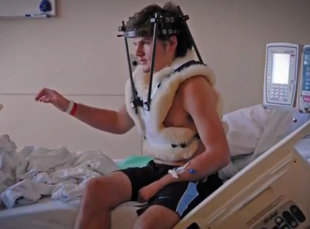Freak Accident inspires Advocacy Group
Freak Accident inspires Advocacy Group, Advocates for Injured Athletes Aims to Arm Student Athletes with Life-saving Knowledge, After Tommy Mallon survived a brutal lacrosse injury, he took action to protect student athletes. Tommy Mallon, a senior at Santa Fe Christian school in San Diego, was two minutes away from the end of the last varsity lacrosse game of the season when it happened.
"I was running for a ground ball and collided with an opposing athlete," he told Yahoo! Shine. "And I went down."
"It was shocking, first of all, because the collision between Tommy and the other player did not look serious at all," his mother, Beth Mallon, told Yahoo! Shine. "It didn't look like a bad hit. It wasn't anything out of the ordinary."
Tommy said he was fine and wanted to get back to the game, but the school's athletic trainer, Riki Kirchhoff, made him stay on the ground. While trying to figure out if he had a concussion, she saw signs of possible nerve damage, and insisted that the school call an ambulance.
He insisted he was fine. Kirchhoff was sure he was not. And she was right.
The force of the hit had caused Tommy's head to rotate on the top of his spine, bursting the C1 vertebrae. A fragment of bone had bisected the vertebral artery. When the C1 is broken, just turning one's head the wrong way can sever the spinal cord and cause death instantly.
"If I had gotten up, I probably would have died or been a quadriplegic," Tommy says now. He spent months in a neck brace and months more in a halo-type brace, waiting for his injuries to heal and hoping to avoid having to have his top four vertebrae fused together, a risky operation in and of itself. His athletic trainer, he says, "basically saved my life."
According to the National Athletic Trainers' Association (NATA), only about 42 percent of high schools in the United States have access to an athletic trainer. Unlike personal trainers, who are focused on fitness and conditioning, athletic trainers are medical professionals who are certified to prevent, diagnose, and treat injuries and sport-related illnesses. Given that most catastrophic, life-threatening sports injuries happen during practices, not games, having a trained medical professional on hand can mean the difference between life and death.
Since many schools cannot afford to keep an athletic trainer on staff, the Mallons have dedicated themselves to the next best thing: training other student athletes to become first responders. They created Advocates for Injured Athletes (A4IA), a nonprofit organization whose mission is to promote sports safety and provide support, education, and resources to keep athletes safe.
Student athletes "are the first ones on the field and the first ones who might see a student down," Tommy said in an interview. "If one of them can save one life, then that's our goal."
They launched a pilot program called Athletes Saving Athletes this January in San Diego County, starting with students at Tommy's alma mater, the Santa Fe Christian Schools, and quickly expanding to about 10 schools in the county. Coaches and school administrators nominate athletes from each sport to participate in Athletes Saving Athletes, where they learn lifesaving skills like CPR and how to operate an automated external defibrillator (AED) for use in cases of sudden cardiac arrest.
It's hard to believe that a healthy young athlete's heart could suddenly stop beating, but it happens: Earlier this month, an 11-year-old boy suffered sudden cardiac arrest after being hit in the chest during his Little League game in Colonie, N.Y. He was revived after EMTs administered two shocks to his chest with an AED. Football-related head injuries are also on the rise, according to a new survey by the National Center of Catastrophic Sports Injury Research at the University of North Carolina in Chapel Hill, and data from Virginia Tech shows that Pee Wee and Pop Warner football players, ages 6 to 13, make and receive hits to the head that are as hard as the ones dished out by college-level and NFL players.
Certified athletic trainers provide the instruction during Athletes Saving Athletes sessions. "We're not at all trying to replace medical care," Beth Mallon says. "What we're teaching the athletes is signs and symptoms of life-threatening injuries. That can be as simple as what a concussion is, why it's so dangerous to go back into play too soon, what second impact syndrome really is. That knowledge is lifesaving."
"Athletes don't go on CDC websites," she continues. "So we tried to bring it to them in a really fun, creative way, so that by the end of the school day you've got an additional 50 first responders on your campus. That's pretty cool."
These days, Tommy, now 20, is a junior at the University of San Diego majoring in political science. "I'm physically limited," he says candidly. "I can't play lacrosse any more. But I can still hang out and run around with my friends. I've been playing a little pick-up basketball, nothing too rough."
"I'm limited," he says. "But I'm alive."
via: yahoo
